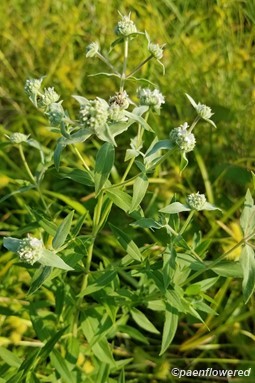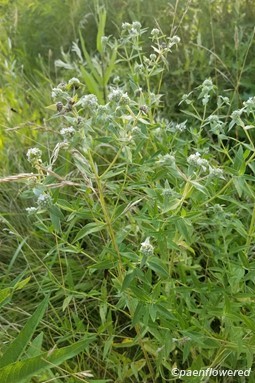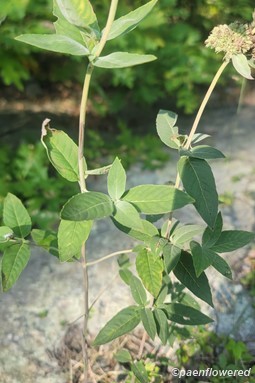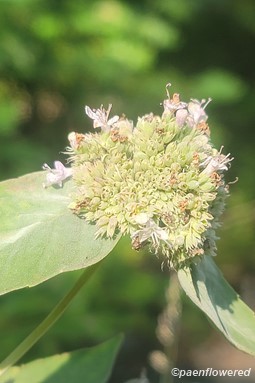Pycnanthemum incanum
Pycnanthemum incanum hoary mountainmint
Hoary mountainmint is a multi-branched, fast-growing, herbaceous perennial known for its aromatic foliage and profusion of tiny white to lavender tubular flowers. Blooming in mid to late summer, the flowers appear in tiered terminal clusters and draw in large numbers of pollinators.
This fragrant plant grows to about 3 feet tall on square stems, with oval, toothed, hoary leaves arranged oppositely on short petioles along the stem. The silvery-white foliage and aromatic fragrance, combined with masses of whitish flowers, create an illusion of coolness during the heat of summer. Seed heads persist into the early autumn months and provide prolonged ornamental interest as well as food for birds.
The common name “mountainmint” is somewhat misleading, as this lovely plant prefers dry open woods, thickets, pastures, clearings, and old fields. It thrives in sunny, acidic sites with rocky or sandy soil, though it can tolerate a range of conditions from dry to wet. Hoary mountainmint is found throughout the Eastern United States and supports a wide variety of wildlife visitors. Its crushed leaves are often used in herbal teas.
Habitat & Range
Frequent in old fields and barrens, tolerates rocky and sandy conditions. Prefers full sun to partial shade and dry to medium, well-drained soil.
Present throughout the state.
Range: Eastern United States from Maine to Illinois south to eastern Texas and northern Florida.
Wetland Code: Not classified
Phenology
Flowers July to September. Blooming period is 4 to 6 weeks.
Characteristics
Inflorescence crowded, head-like clusters (rounded cymes) terminating the main stem and branches or in axils of upper leaves; loose flowering heads ½ to 2″ across
Flowers small; corolla white to lavender with purple spots on lower lip; 4 stamens tucked inside the corolla; 5 petals fused into upper (2 lobes) and lower (3 lobes) lip
Leaves opposite, simple, ovate to ovate-oblong, green-gray to silvery green; leaf surfaces hoary, more so on the underside (covered with short whitish hairs); remotely toothed; 4″ long, 1 ½″ wide
Stems square, branch in upper half; upper stems densely pillose
Fruit indehiscent dry, ovoid nutlets, usually black, nesteled into brown, button-like cymes; each flower has 4 nutlets; one seed per nutlet
Height 2-3 feet avg, can grow up to 6 feet; spread 3 to 4 feet
Plant Codes
S-rank: S5 (Secure)
G-rank: G5 (Secure)
Ecology
Provides nectar for a wide range of pollinators, attracting butterflies, bees, wasps, flies, and other beneficial insects.
Its minty scent and bitter taste make it unappealing to deer, rabbits, groundhogs, and voles, offering natural resistance to browsing. The dry seed heads may also serve as a modest food source for birds, especially in leaner seasons.








Comments
Have you spotted this plant in your area? We'd love to hear about your experience! Share your comments or questions about the plant below. Comments are moderated before posting.